Cloud Computing: History, Problem, Solution, and Deployment Models
Added on 2023-01-12
24 Pages5323 Words93 Views
Cloud Computing
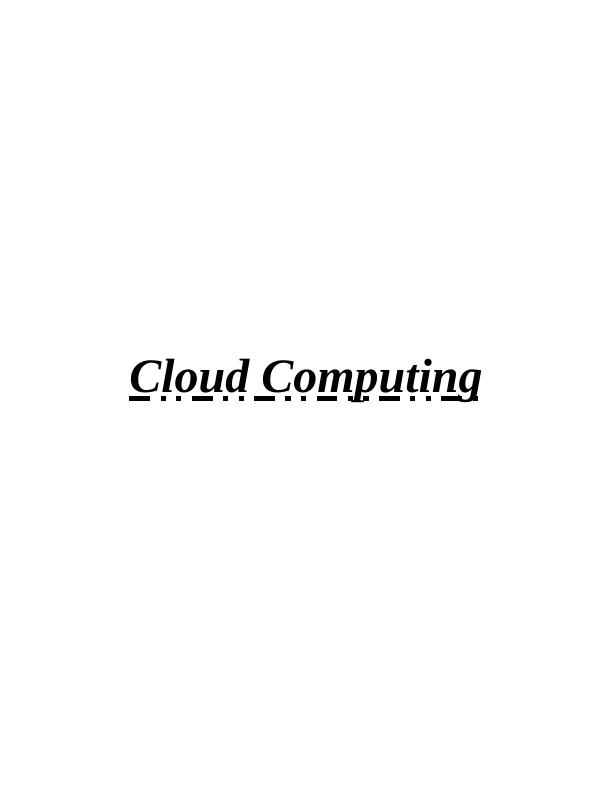
Table of Contents
Introduction.................................................................................................................................................3
Background of cloud and its evolution....................................................................................................3
Problem and solution...............................................................................................................................4
Appropriateness of solution.....................................................................................................................5
Architectural design.................................................................................................................................5
Deployment Model..................................................................................................................................7
Service Model..........................................................................................................................................8
Data Migration........................................................................................................................................9
Configuration of cloud with CSP framework........................................................................................10
Implementation of cloud platform using open source tool.....................................................................12
Probable solution to problems...............................................................................................................14
Security issues.......................................................................................................................................15
Ways to overcome issues.......................................................................................................................15
Conclusion.................................................................................................................................................16
References.................................................................................................................................................17
Introduction.................................................................................................................................................3
Background of cloud and its evolution....................................................................................................3
Problem and solution...............................................................................................................................4
Appropriateness of solution.....................................................................................................................5
Architectural design.................................................................................................................................5
Deployment Model..................................................................................................................................7
Service Model..........................................................................................................................................8
Data Migration........................................................................................................................................9
Configuration of cloud with CSP framework........................................................................................10
Implementation of cloud platform using open source tool.....................................................................12
Probable solution to problems...............................................................................................................14
Security issues.......................................................................................................................................15
Ways to overcome issues.......................................................................................................................15
Conclusion.................................................................................................................................................16
References.................................................................................................................................................17
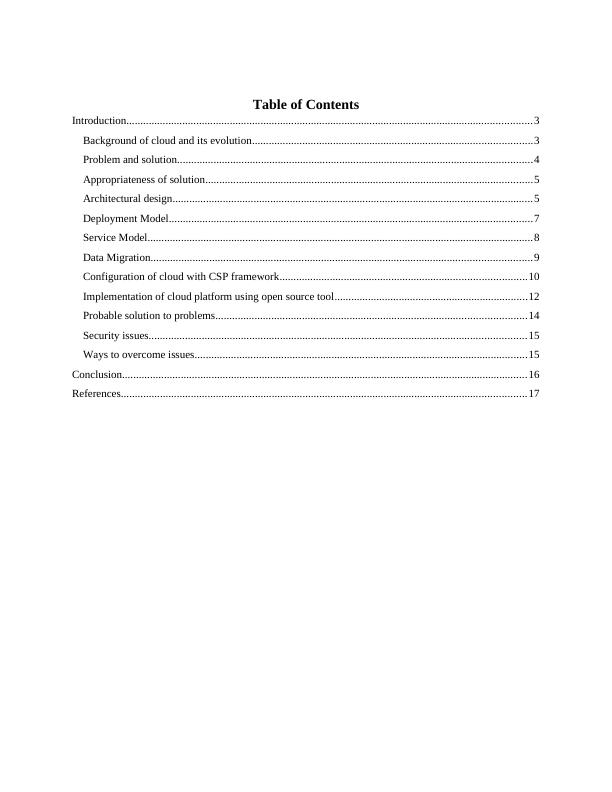
Introduction
According to Microsoft, Cloud computing implies delivery of computing services which
includes database, networking, servers, intelligence, analytics and software over internet for
offering flexible resources, economies of scale and faster innovation (What is cloud computing?,
2020). Basically, it implies furnishing of on-demand computing services which varies from app
to storage along with processing power via internet as well as pay as you go basis. To understand
the concept of cloud computing Fastfix is taken into consideration which provides Matika tools
at minimum prices. They are from Bristol who are official distributors from 1990 and renders
online tools. This report comprises of history of cloud, description of problem, solution and its
relevance. Furthermore, it also includes service and deployment models along with data
migration. Along with this, some cloud computing solutions are also implemented that are
provided by cloud service providers and as open source tool. Certain issues along with their
solutions will also be discussed.
Background of cloud and its evolution
The type of computing which is dependent on shared computing resources instead of
personal devices or local servers for handling applications is referred to as cloud computing. The
rationale behind cloud computing is that in 1950s mainframe computing was utilized; they were
huge as well as expensive. For this reason, time sharing schedule were implemented that enabled
users to have access central mainframe systems via connected stations. It provided a shared
computational power and from here cloud computing started (Kumar and Kumar, 2013). In
1960’s, enhancement came in this when American computer scientist conceptualized the concept
of interconnected system of computers. In 1969, ARPANET (Advanced Research Projects
Agency Network) which permitted sharing of digital sources that are not present at physical
location. Virtual machine operating system was released by IBM in s1972 and in this way the
process of sharing data via online medium evolved by making use of internet.
According to Microsoft, Cloud computing implies delivery of computing services which
includes database, networking, servers, intelligence, analytics and software over internet for
offering flexible resources, economies of scale and faster innovation (What is cloud computing?,
2020). Basically, it implies furnishing of on-demand computing services which varies from app
to storage along with processing power via internet as well as pay as you go basis. To understand
the concept of cloud computing Fastfix is taken into consideration which provides Matika tools
at minimum prices. They are from Bristol who are official distributors from 1990 and renders
online tools. This report comprises of history of cloud, description of problem, solution and its
relevance. Furthermore, it also includes service and deployment models along with data
migration. Along with this, some cloud computing solutions are also implemented that are
provided by cloud service providers and as open source tool. Certain issues along with their
solutions will also be discussed.
Background of cloud and its evolution
The type of computing which is dependent on shared computing resources instead of
personal devices or local servers for handling applications is referred to as cloud computing. The
rationale behind cloud computing is that in 1950s mainframe computing was utilized; they were
huge as well as expensive. For this reason, time sharing schedule were implemented that enabled
users to have access central mainframe systems via connected stations. It provided a shared
computational power and from here cloud computing started (Kumar and Kumar, 2013). In
1960’s, enhancement came in this when American computer scientist conceptualized the concept
of interconnected system of computers. In 1969, ARPANET (Advanced Research Projects
Agency Network) which permitted sharing of digital sources that are not present at physical
location. Virtual machine operating system was released by IBM in s1972 and in this way the
process of sharing data via online medium evolved by making use of internet.
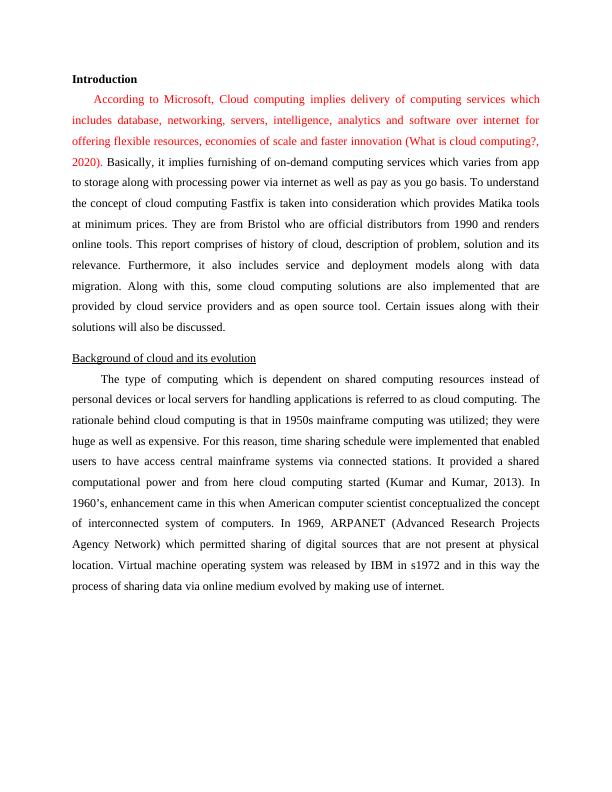
Illustration 1: The History of the Cloud
AWS (Amazon Web Services) was brought within market in early 2000’s then in 2006
Amazon released EC2 (Elastic Compute Cloud) which allowed individuals as well as firms to
rent virtual systems by which firm like Fastfix can make use of their applications as well as
programs. From then there has been a explosive growth within cloud computing and it is being
widely used. Large firms like Adobe, Oracle, Microsoft, etc. are providing different options to
other organizations. There has to be a service level agreement (SLA) which takes place among
vendor and user. Along with this, service provider will be answerable to users if as per the
agreement services are not delivered to them.
Problem and solution
Fastfix provides their customers Matika tools which are supplied with UK Makita warranty
and they will also give UK VAT invoice when products are bought by them. This clearly
illustrates that firm provides authorized services but their customers and even employees goes
through certain problems. There is no instant response, lack of quick access and ineffectiveness
in business processes (Lee, 2012). These problems can be handled by cloud computing. The
reason behind this can be understood by taking some examples in this context, Google Assistant,
Alexa and Siri are cloud dependent bots which leverage computing capabilities to furnish
personalized customer experiences. Time which is needed for accessing services was more as
there was no centralized database that will enable to have delays within their project. This leads
AWS (Amazon Web Services) was brought within market in early 2000’s then in 2006
Amazon released EC2 (Elastic Compute Cloud) which allowed individuals as well as firms to
rent virtual systems by which firm like Fastfix can make use of their applications as well as
programs. From then there has been a explosive growth within cloud computing and it is being
widely used. Large firms like Adobe, Oracle, Microsoft, etc. are providing different options to
other organizations. There has to be a service level agreement (SLA) which takes place among
vendor and user. Along with this, service provider will be answerable to users if as per the
agreement services are not delivered to them.
Problem and solution
Fastfix provides their customers Matika tools which are supplied with UK Makita warranty
and they will also give UK VAT invoice when products are bought by them. This clearly
illustrates that firm provides authorized services but their customers and even employees goes
through certain problems. There is no instant response, lack of quick access and ineffectiveness
in business processes (Lee, 2012). These problems can be handled by cloud computing. The
reason behind this can be understood by taking some examples in this context, Google Assistant,
Alexa and Siri are cloud dependent bots which leverage computing capabilities to furnish
personalized customer experiences. Time which is needed for accessing services was more as
there was no centralized database that will enable to have delays within their project. This leads

to create a negative impact on organization as well as their productivity. This implies that instant
response and quick access to data will be attained by individuals depending upon whether they
are clients or employees. Chatbots have expanded computing power as well as capacity of cloud
as through this preferences about users are stored. That aids within furnishing quick response as
well as access.
There is ineffectiveness in the way services are being carried out by Fastfix as adequate
response is not provided to their customers (Modi and et. al, 2013). This denotes that there is a
need for relevant business processes that involves ERP (Enterprise Resource Planning) and CRM
(Customer Relationship Management). Marketo, Hubspot, Salesforce are instances of cloud
service providers. This method is efficient as well as cost effective for Fastfix as it will enable
them to manage their operations without any kind of hassle and security of critical business
resources. Along with this, it will enable firm within formulation of plans accordingly, monitor
overall activities carried out. This implies that cloud computing is an appropriate solution for an
organization.
Appropriateness of solution
As per the above discussion, it has been identified that cloud computing is an adequate
solution as it will allow firm to have amplified functionalities. It is a model that enables
ubiquitous, on-demand and convenient network access for computing resources, The
appropriateness of cloud computing can be understood by taking into account certain fact that it
will enable Fastfix to have resource pooling as this furnish services to various customers (Nabi,
Jamwal and Padmanbh, 2020). This will allow all stakeholders to have access to virtual
resources. Furthermore, the downtime will be low and updates are also compatible as well as
bugs can be fixed faster.
Architectural design
The technological model comprises of architecture on the basis of which entire model
carries their functions that will illustrate hierarchical view for describing technology. This will
illustrate the dependencies on which firm will work on (Neware and et. al, 2020). With respect to
Fastfix, the architectural design is illustrated below:
response and quick access to data will be attained by individuals depending upon whether they
are clients or employees. Chatbots have expanded computing power as well as capacity of cloud
as through this preferences about users are stored. That aids within furnishing quick response as
well as access.
There is ineffectiveness in the way services are being carried out by Fastfix as adequate
response is not provided to their customers (Modi and et. al, 2013). This denotes that there is a
need for relevant business processes that involves ERP (Enterprise Resource Planning) and CRM
(Customer Relationship Management). Marketo, Hubspot, Salesforce are instances of cloud
service providers. This method is efficient as well as cost effective for Fastfix as it will enable
them to manage their operations without any kind of hassle and security of critical business
resources. Along with this, it will enable firm within formulation of plans accordingly, monitor
overall activities carried out. This implies that cloud computing is an appropriate solution for an
organization.
Appropriateness of solution
As per the above discussion, it has been identified that cloud computing is an adequate
solution as it will allow firm to have amplified functionalities. It is a model that enables
ubiquitous, on-demand and convenient network access for computing resources, The
appropriateness of cloud computing can be understood by taking into account certain fact that it
will enable Fastfix to have resource pooling as this furnish services to various customers (Nabi,
Jamwal and Padmanbh, 2020). This will allow all stakeholders to have access to virtual
resources. Furthermore, the downtime will be low and updates are also compatible as well as
bugs can be fixed faster.
Architectural design
The technological model comprises of architecture on the basis of which entire model
carries their functions that will illustrate hierarchical view for describing technology. This will
illustrate the dependencies on which firm will work on (Neware and et. al, 2020). With respect to
Fastfix, the architectural design is illustrated below:
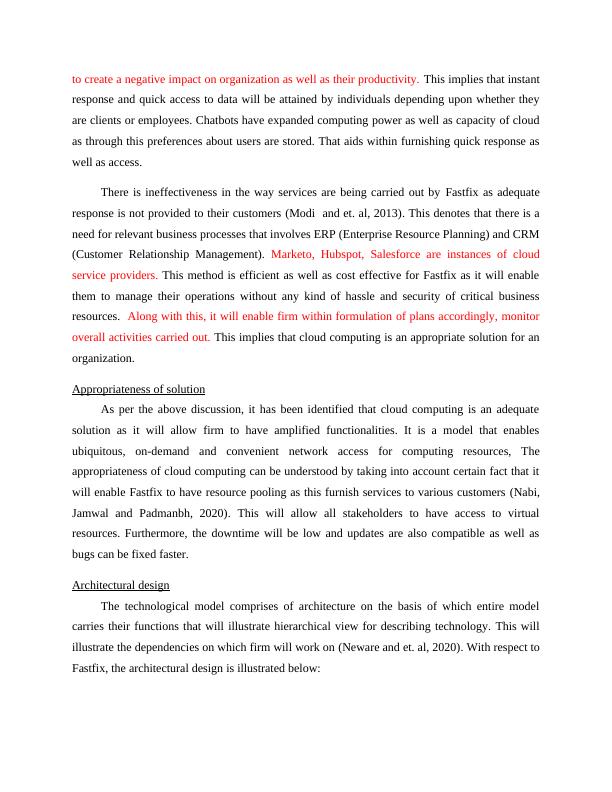
Illustration 2: Cloud Architecture for Fastfix
The requirements of the employees will be present with Administrative management of
Fastfix and then it will be given to employees for examining them (Parekh and Sridaran, 2013).
After this is being done, their requirements are being furnished after they clear payment
gateways.
Illustration 3: Front and Back-End Framework
The requirements of the employees will be present with Administrative management of
Fastfix and then it will be given to employees for examining them (Parekh and Sridaran, 2013).
After this is being done, their requirements are being furnished after they clear payment
gateways.
Illustration 3: Front and Back-End Framework
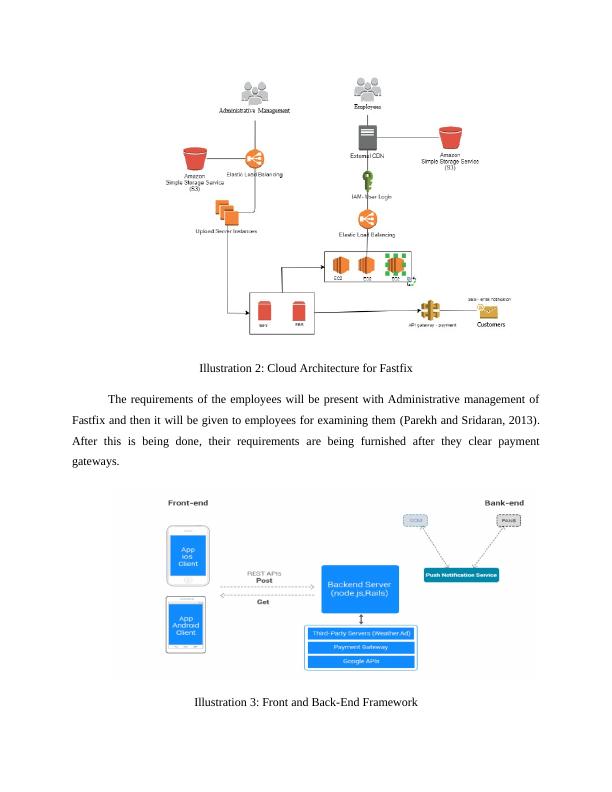
End of preview
Want to access all the pages? Upload your documents or become a member.
Related Documents
Cloud Computing: Web Server Solutions, Office Automation, and Cloud Modelslg...
|17
|1370
|21
Cloud Computing and Usage of Development Modelslg...
|18
|4818
|63
Issues of Cloud Computing and Research Opportunitieslg...
|8
|2180
|443
Evaluate Cloud Architecturelg...
|11
|1697
|300
Virtualisation and Cloud Computing PDFlg...
|9
|1856
|161
Types of Cloud Computing Architecture - PDFlg...
|11
|1546
|242
